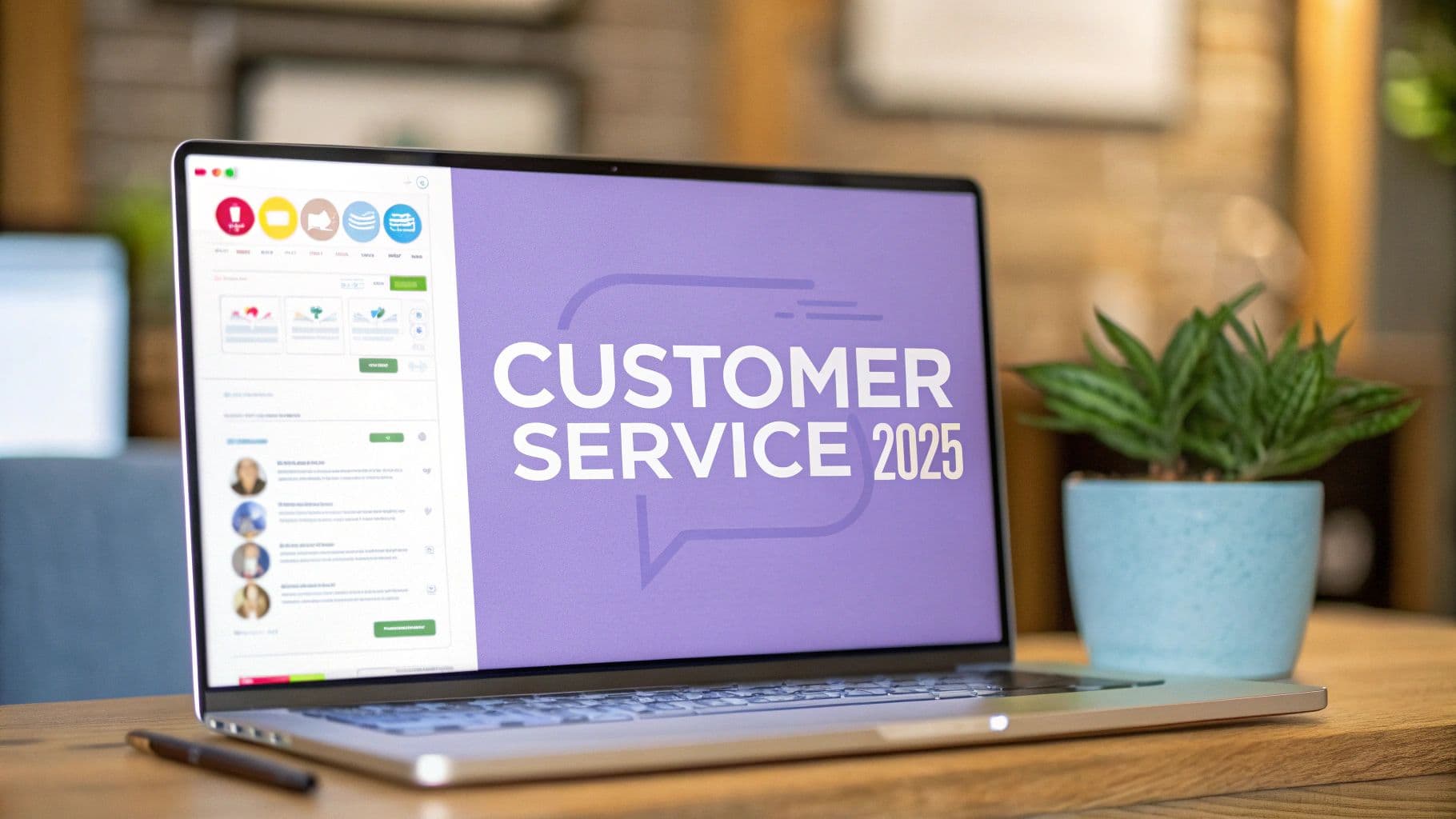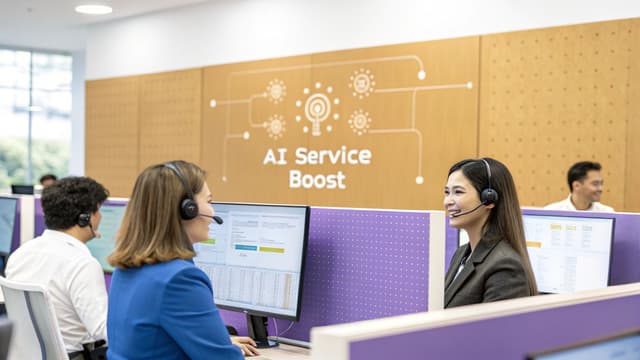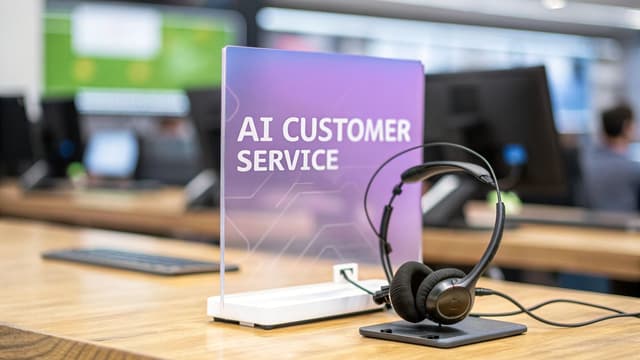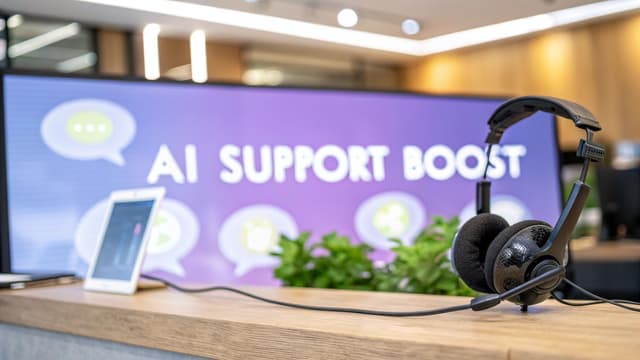In 2024, the landscape of customer service is being fundamentally reshaped by artificial intelligence. Support is no longer confined to human agents answering phones during business hours. Instead, businesses are deploying sophisticated AI to provide instant, 24/7 assistance across diverse channels like WhatsApp, Slack, and website chat, and ensure multilingual customer service. However, this technological leap doesn't replace the core principles of exceptional service; it elevates them. To succeed, companies must adopt a new blueprint, a set of modern customer service guidelines that harmonize AI's efficiency with the irreplaceable human touch.
This guide moves beyond generic advice to provide a clear, actionable framework for this new reality. We will explore 8 foundational guidelines, offering specific strategies to deploy intelligent automation while fostering genuine customer loyalty and satisfaction. These aren't just abstract best practices; they are the essential rules for thriving in a customer-centric environment powered by AI. Mastering this approach requires understanding its foundational value; a great starting point is to explore the typical benefits of chatbots for a business. From there, you can begin to build a support system that is both highly efficient and deeply human.
1. Guideline 1: Scale Empathy with Hybrid Human-AI Active Listening
Traditional active listening is a cornerstone of excellent support, but it presents a significant scaling challenge for growing businesses. This modern guideline reimagines the concept by creating a hybrid system where AI handles initial empathetic engagement, freeing human agents for complex emotional issues. This approach ensures every customer feels heard from the first point of contact, 24/7.
The core principle is to engineer empathy into your automated systems. This goes beyond simple keyword recognition. It involves training AI models to identify customer intent, analyze sentiment (like frustration or confusion), and detect specific emotional trigger words. This allows the AI to serve as an empathetic first responder, validating customer feelings before attempting to solve the problem.
How to Implement Hybrid Active Listening
Implementing this strategy involves a two-pronged approach that focuses on both technology and human workflow integration.
- AI Training and Configuration: Start by feeding your AI historical customer service data, including chat transcripts and support tickets. This teaches it to recognize patterns in language that signal specific emotions. Configure your AI to use empathetic "phrasing frameworks" that paraphrase and confirm the customer's issue.
- Define Escalation Triggers: Clearly establish rules for when the AI should hand off a conversation. These triggers shouldn't just be based on unresolved queries but also on detected emotional intensity. For instance, if a customer uses language indicating high distress, the AI should immediately offer to connect them with a human agent.
Key Insight: The goal isn't for AI to replace human empathy but to amplify it. The AI handles the initial acknowledgment and validation at scale, ensuring human agents can apply their deeper emotional intelligence where it delivers the most value.
Real-World Application
Consider an e-commerce brand's AI chatbot. When a customer types, "Where is my package? It's been two weeks!", a basic bot might just ask for the order number. A hybrid model, however, responds differently: "I can see why you're concerned about the delay; waiting for an order is definitely frustrating. Let me pull up the real-time tracking information for you right now." This small shift in language validates the customer's emotion, making the interaction feel more human and supportive. This is one of the most effective customer service guidelines for building trust from the very first interaction.
2. Prioritize First Contact Resolution (FCR) for Immediate Satisfaction
First Contact Resolution (FCR) is a foundational metric focused on completely resolving a customer's issue during their initial interaction, eliminating the need for follow-ups. While not a new concept, its application in the modern, fast-paced digital environment is more critical than ever. Achieving high FCR rates directly boosts customer satisfaction, reduces operational costs, and builds long-term loyalty by demonstrating efficiency and respect for the customer's time.

The core principle is empowerment. A support agent, whether human or AI, must have the knowledge, tools, and authority to solve the problem on the spot. This requires a shift from a tiered, multi-touch support model to one where the first point of contact is also the most effective. This proactive approach prevents customer frustration from escalating and reinforces their confidence in your brand.
How to Implement First Contact Resolution
Success with FCR depends on creating an ecosystem where agents are equipped for immediate problem-solving, supported by both robust training and intelligent technology.
- Empower and Equip Agents: Provide comprehensive training on all products, services, and common issues. Grant agents access to a unified customer dashboard that displays order history, past interactions, and account details. Empower them with the authority to process refunds, apply discounts, or make other decisions without needing a manager's approval.
- Utilize an Integrated Knowledge Base: Implement a centralized, easily searchable knowledge base that provides quick-reference guides, troubleshooting steps, and policy details. Integrating this directly into your support platform allows AI bots to pull answers and human agents to find information without putting the customer on hold.
Key Insight: True FCR isn't just about closing tickets faster; it's about making the first interaction the only necessary interaction. This requires investing in your team's expertise and the systems that support them, transforming your service center from a cost center into a value-driver.
Real-World Application
Imagine a customer of a financial services company like USAA calling about a suspicious charge on their credit card. An FCR-focused agent can immediately verify the customer's identity, review the transaction, freeze the card, issue a new one, and reverse the charge, all within a single phone call. This is possible because the agent is trained in security protocols and has the system access and authority to perform all necessary actions. These comprehensive customer service guidelines ensure the customer ends the call with complete resolution and peace of mind, solidifying their trust in the institution.
3. Proactive Customer Communication
Exceptional customer service isn't just about reacting to problems; it's about preventing them before they arise. Proactive communication is a forward-thinking guideline that shifts the support model from reactive to preemptive. It involves anticipating customer needs and reaching out with valuable information or solutions before the customer even thinks to ask. This approach transforms the customer experience from a series of support tickets into a seamless, guided journey.
The core of this strategy is using data and automation to predict what a customer will need next. By analyzing behavior, purchase history, and usage patterns, businesses can identify potential friction points or opportunities for delight. This allows them to send timely, relevant messages that solve problems in advance, provide helpful guidance, and strengthen the customer relationship by showing you are one step ahead.
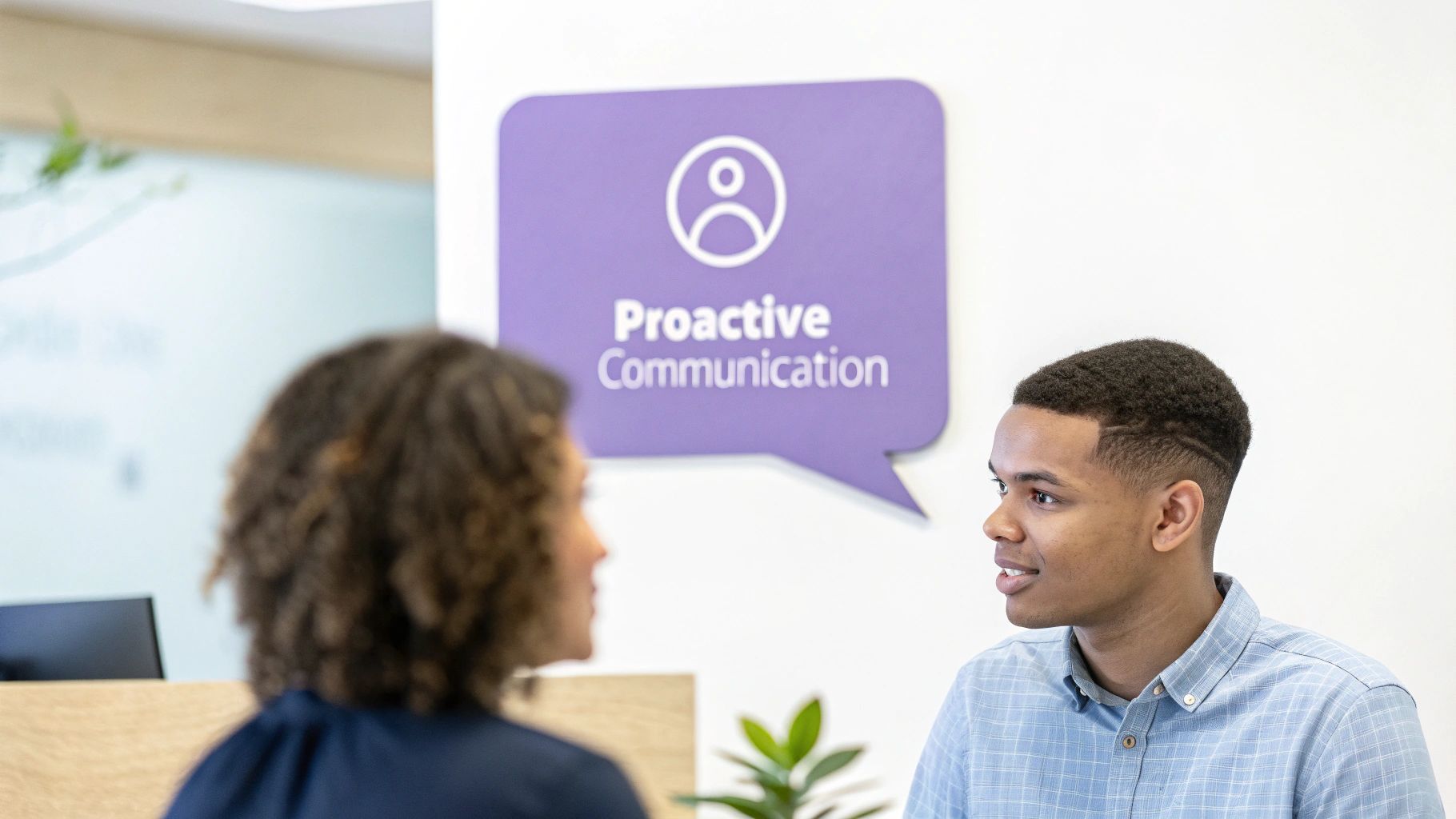
How to Implement Proactive Communication
Implementing this guideline requires a strategic blend of customer segmentation, automation tools, and a value-first mindset.
- Segment and Personalize: Group your customers based on their lifecycle stage, behavior, or preferences. A new user might receive onboarding tips, while a long-time customer could get a notification about a new feature relevant to their usage. This ensures every message feels personal and valuable.
- Leverage Multi-Channel Outreach: Use the right channel for the right message. An urgent fraud alert from a bank is best sent via SMS, while a content recommendation from Netflix is perfect for an in-app notification or email. The key is to be where your customer is, without being intrusive.
Key Insight: Proactive communication changes the customer's perception of your brand. Instead of seeing you as a company that just fixes things when they break, they see you as a trusted partner invested in their success and satisfaction.
Real-World Application
Consider how a logistics company like FedEx uses this. Instead of making you manually track your package, it proactively sends alerts for shipment confirmations, delays, and delivery completions. This preemptive information manages expectations and prevents a flood of "Where is my order?" inquiries. Similarly, when Bank of America detects unusual account activity, it sends an immediate alert, empowering the customer to act fast. These customer service guidelines build immense trust and reduce the burden on reactive support channels, showcasing the power of getting ahead of the problem.
4. Guideline: Champion Omnichannel Consistency for a Unified Customer Journey
Customers no longer interact with a business through a single channel; they expect a fluid experience whether they are on your website, using your mobile app, or speaking to an agent. Omnichannel consistency ensures that the quality of service, brand voice, and customer data remain coherent across every touchpoint. This approach breaks down silos between departments and channels to create one seamless, unified customer reality.
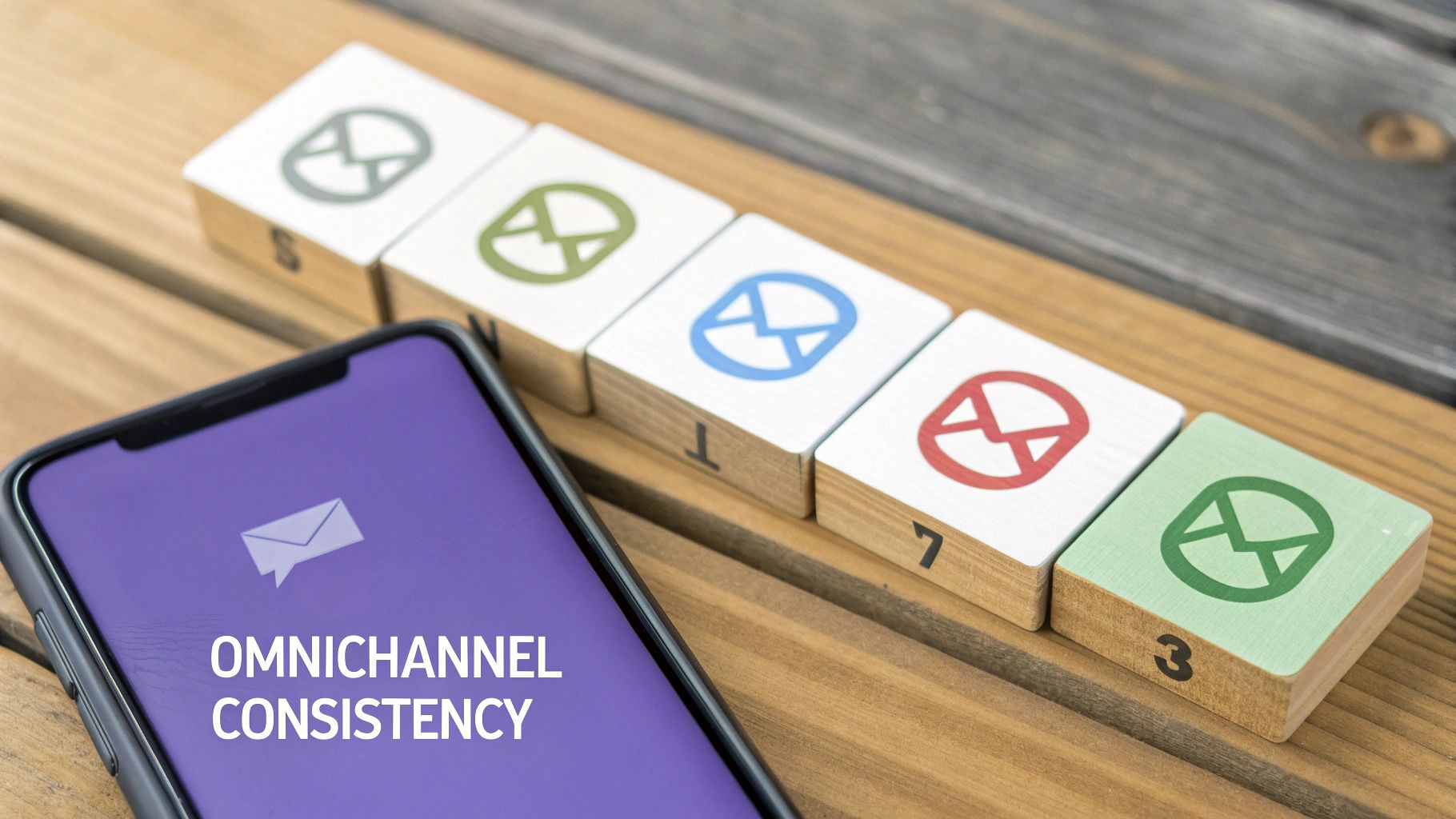
The core idea is to build a support ecosystem where context and history travel with the customer. If a customer starts a chat on your website, they should be able to continue that same conversation via email without having to repeat themselves. This requires integrating your technology stack and aligning your teams to present a single, authoritative front to the customer, which is a foundational principle for modern support.
How to Implement Omnichannel Consistency
Achieving true omnichannel service involves a strategic blend of technology integration and operational alignment. It requires a commitment to viewing the customer experience as a whole, rather than a series of separate interactions.
- Integrate Your CRM: Invest in a robust Customer Relationship Management (CRM) system, like Salesforce or Microsoft Dynamics 365, that acts as a central hub for all customer data. This system should unify interaction histories from email, chat, phone, and social media into a single customer profile.
- Standardize Training and Protocols: Develop a universal set of service standards, communication guidelines, and escalation procedures that apply to every channel. An agent handling a phone call should provide the same information and level of service as one managing a social media inquiry.
Key Insight: True omnichannel support is not just about being available on multiple channels; it's about making those channels work together intelligently. The goal is to make channel-switching invisible to the customer, creating an effortless and continuous conversation.
Real-World Application
Consider a retail brand like Target. A customer can browse for an item on the mobile app, check its real-time stock at a nearby store, place an order for in-store pickup, and receive an email notification when it's ready. If they have an issue, they can initiate a chat in the app, and the agent will already have their order details and purchase history. This unified experience is a powerful example of effective customer service guidelines in action, turning potential friction into a smooth, convenient journey. For businesses looking to build a similar seamless system, understanding the principles of omnichannel customer service on flowgent.ai is an essential first step.
5. Personalization and Customer Recognition
Treating customers as unique individuals rather than anonymous ticket numbers is a powerful retention strategy. This guideline focuses on tailoring interactions, solutions, and recommendations based on a customer's specific history, preferences, and behavior. By recognizing a customer's past journey, you demonstrate that their relationship with your brand is valued.
The core principle is to leverage customer data to create a seamless, context-aware support experience. When a returning customer contacts you, your systems should already know who they are, what they’ve purchased, and what issues they’ve faced before. This eliminates the frustrating need for customers to repeat themselves and allows agents to provide faster, more relevant solutions. This approach transforms a transactional service interaction into a relational one.
How to Implement Personalization
Effective personalization requires a strategic approach to data management and interaction design, ensuring every touchpoint feels relevant.
- Integrate Your Data Sources: Connect your CRM, e-commerce platform, and helpdesk software. This creates a unified customer profile that gives support agents a 360-degree view of the customer's history, enabling them to reference past purchases or support tickets.
- Use Dynamic Content and Recommendations: Program your AI chatbots and agent dashboards to surface personalized information. For example, if a customer asks about a return, the system should automatically reference their most recent order instead of asking for an order number. This thoughtful application of data is central to effective customer service guidelines.
Key Insight: True personalization isn't just about using a customer's name. It's about using their history and context to anticipate their needs and reduce their effort, making them feel seen and understood.
Real-World Application
Consider a subscription software company. A customer's free trial is about to expire, and they contact support with a question about a specific premium feature. A generic response would simply answer the question. A personalized approach, however, would have the AI or agent say, "I see you've been using the project management tool extensively during your trial. To answer your question about the advanced reporting feature, it's perfect for tracking team productivity, which seems important for your workflow." This contextual awareness, a key aspect of customer journey orchestration, directly connects the solution to the customer's observed behavior, making the value proposition clear and personal.
6. Continuous Improvement and Feedback Loop
Excellent customer service is not a static goal but an evolving process. This guideline moves beyond one-time fixes to establish a systematic cycle of collecting, analyzing, and acting on feedback. Inspired by principles like Toyota's Kaizen philosophy, it treats every customer interaction and data point as an opportunity to refine and optimize service delivery. This creates a resilient, customer-centric support ecosystem that adapts to changing expectations.
The core of this approach is building a robust feedback loop where insights from customers, agents, and performance metrics are continuously funneled back into the system for enhancement. It means that customer service isn't just about resolving today's tickets; it's about making tomorrow's service inherently better, more efficient, and more aligned with customer needs.
How to Implement a Continuous Improvement Loop
Creating a self-improving service model requires structured processes for gathering and implementing feedback, both from humans and AI.
- Implement Diverse Feedback Channels: Don't rely on a single survey. Use a mix of methods like post-interaction CSAT/NPS surveys, user forums, agent feedback sessions, and AI-driven sentiment analysis on chat transcripts. This provides a holistic view of service quality.
- Establish a Review Cadence: Schedule regular, cross-functional meetings (e.g., weekly or bi-weekly) dedicated to reviewing service metrics, key customer feedback, and agent performance. This ensures that analysis translates into concrete action items and accountability.
Key Insight: The most powerful feedback loops are "closed loops." This means you not only implement changes based on feedback but also communicate those changes back to the customers and agents who suggested them. This validates their contribution and fosters a culture of collaborative improvement.
Real-World Application
Imagine an online software company using this principle. After analyzing support tickets, they notice a recurring issue with their billing dashboard. Instead of just answering each ticket, their cross-functional improvement team prioritizes a UI update to clarify the billing information. Once deployed, they send an email to users who had reported the issue, informing them of the fix. This proactive approach is one of the most effective customer service guidelines for reducing future support volume and demonstrating a genuine commitment to the user experience.
7. Guideline 7: Foster Proactive Problem-Solving with Employee Empowerment
While AI can automate resolutions, true customer loyalty is often forged when a human agent goes above and beyond. This guideline centers on empowering your support team with the authority, knowledge, and resources to solve customer issues independently, without needing constant managerial approval. It shifts the support dynamic from a rigid, script-based process to a flexible, results-oriented framework where agents can make real-time decisions that benefit the customer.
The core principle is trust. By entrusting agents with decision-making power, you communicate that you value their judgment and expertise. This empowerment directly correlates with faster resolutions, higher employee morale, and a more personalized customer experience. It transforms agents from mere problem-loggers into genuine customer advocates.
How to Implement Employee Empowerment
Successfully implementing this guideline requires building a supportive structure that enables confident decision-making while maintaining accountability.
- Establish Clear Boundaries: Define a clear framework for empowerment. For instance, like Ritz-Carlton's famous policy, you might grant agents a specific budget (e.g., $50) to resolve an issue without escalation. Document these guidelines and make them easily accessible.
- Invest in Comprehensive Training: Empowerment is ineffective without knowledge. Provide continuous training on products, policies, and problem-solving techniques. Create mentorship programs where experienced agents can guide new hires through complex customer scenarios, reinforcing their confidence.
Key Insight: Empowerment isn't about giving agents unlimited authority; it's about giving them the right authority within well-defined parameters. This builds an environment where employees are confident in making decisions that align with company values and customer satisfaction goals.
Real-World Application
Imagine a SaaS customer contacts support because a critical feature they rely on is bugged right before a major presentation. A disempowered agent might only be able to say, "I've logged a ticket with engineering and will let you know when it's fixed." An empowered agent, however, could take initiative. They might say, "I understand how urgent this is. I’ve escalated your ticket, and while our engineers work on a permanent fix, I've temporarily credited your account with access to a premium feature that offers a workaround." This proactive solution turns a potential crisis into a demonstration of exceptional care, a hallmark of effective customer service guidelines.
8. Guideline 8: Codify Response Time and Accessibility Standards
A fundamental guideline for any support operation is establishing clear, documented standards for how quickly and easily customers can get help. This involves codifying response time targets and accessibility across all channels, moving beyond vague promises to create concrete Service Level Agreements (SLAs). This structured approach, popularized by frameworks like ITIL, manages customer expectations and provides a clear benchmark for team performance.
This principle is about operationalizing your commitment to timely support. Instead of simply aiming to be "fast," you define what "fast" means for each channel. Is it a 60-second response on live chat? A 6-hour reply to an email? A 24/7 phone line? These standards become the backbone of your service delivery, influencing staffing, technology choices, and customer satisfaction.
How to Implement Formal Standards
Setting up these standards requires a methodical approach that balances customer expectations with your operational capabilities.
- Benchmark and Set Realistic Goals: Analyze your current performance and research industry standards for your sector. Set ambitious but achievable response time goals for each channel (e.g., live chat, email, phone). Zappos became legendary for its 24/7 phone support, while Buffer built trust with a same-day email response commitment.
- Communicate and Automate: Clearly display your expected response times on your website and in automated acknowledgment emails or chat messages. This immediately manages customer expectations. Use queue management systems and auto-responders to confirm receipt and provide an estimated wait time, which reduces perceived waiting.
Key Insight: Accessibility is as crucial as speed. A rapid response is useless if a customer can't easily find a way to contact you. Your standards must cover both how fast you respond and how easy it is to initiate contact on the customer's preferred channel.
Real-World Application
Imagine an online software provider that offers tiered support plans. A basic plan might guarantee a 24-hour email response. A premium plan, similar to the priority service for American Express cardholders, could offer a guaranteed sub-one-minute response on live chat and a dedicated phone line. By codifying these standards, the company not only creates clear value for its premium tiers but also establishes a reliable performance metric for its support teams. These transparent and consistent customer service guidelines build significant customer trust and loyalty. You can improve your customer service response time on flowgent.ai by implementing similar strategies.
Customer Service Guidelines Comparison Matrix
| Guideline | Implementation Complexity 🔄 | Resource Requirements ⚡ | Expected Outcomes 📊 | Ideal Use Cases 💡 | Key Advantages ⭐ |
|---|---|---|---|---|---|
| Active Listening and Empathy | Medium-High: Requires extensive training and emotional effort | High: Time-intensive interactions and training | Stronger relationships, higher satisfaction, emotional connection | High-touch, relationship-focused service environments | Builds trust and reduces escalation |
| First Contact Resolution (FCR) | High: Needs skilled reps and robust tools | High: Training, tech investment, skilled staff | Improved satisfaction, lower operational costs, loyalty boost | Complex issues needing fast, thorough resolution | Reduces repeat contacts and customer effort |
| Proactive Customer Communication | High: Involves sophisticated systems and data analysis | Medium-High: Automation tools and analytics | Prevented issues, increased engagement, fewer support requests | Services aiming to preempt problems or educate customers | Enhances loyalty by anticipating needs |
| Omnichannel Consistency | Very High: Complex integration and coordination required | Very High: Technology, training, organizational change | Seamless experience, increased satisfaction, operational efficiency | Businesses with multiple customer touchpoints | Delivers unified and consistent customer experience |
| Personalization and Customer Recognition | High: Extensive data collection and management | High: Data infrastructure and privacy compliance | Higher satisfaction, improved conversion, emotional connection | Customer-centric marketing and service strategies | Drives loyalty through tailored experiences |
| Continuous Improvement and Feedback Loop | Medium-High: Needs cultural adoption and process setup | Medium: Resources for feedback and analysis | Ongoing service enhancement, problem identification, innovation | Organizations focused on service excellence | Enables data-driven quality improvements |
| Employee Empowerment and Training | Medium-High: Substantial training and policy development | High: Investment in training and coaching | Faster resolutions, engaged employees, better FCR | Companies focusing on frontline employee autonomy | Improves responsiveness and reduces escalations |
| Response Time and Accessibility Standards | Medium: Defined standards and monitoring systems needed | Medium-High: Staffing and technology investments | Clear expectations, improved trust, measurable service levels | Environments with high volume or expectation for speed | Builds customer trust through reliability and availability |
Integrating Intelligence into Your Service Strategy
The journey through these eight essential customer service guidelines reveals a powerful, interconnected framework. From the foundational importance of Active Listening and Empathy to the strategic necessity of Continuous Improvement, each principle serves as a critical pillar supporting a superior customer experience. We've explored how achieving a high First Contact Resolution (FCR) rate builds immediate trust and how Proactive Communication can transform potential problems into opportunities for delight.
The modern customer journey is not linear; it spans multiple touchpoints. This reality makes Omnichannel Consistency and deep Personalization non-negotiable. Customers expect to be recognized and valued, whether they are interacting with a sophisticated AI chatbot or a human agent. Furthermore, setting clear Response Time and Accessibility Standards ensures that your service is not just effective, but also reliably available when your customers need it most.
The Human-AI Synergy: Your Blueprint for Success
Ultimately, the most crucial takeaway is that these guidelines are amplified, not replaced, by technology. Integrating AI-driven solutions is not about removing the human element but about empowering it. By automating routine inquiries and providing agents with rich, contextual data, AI frees up your team to focus on what they do best: applying empathy, solving complex problems, and building genuine relationships. This synergy is the future.
Implementing these principles requires a strategic shift. It's about moving from a reactive support model to a proactive, intelligent, and deeply integrated service operation. This transformation doesn't happen overnight, but the path forward is clear.
Your Actionable Next Steps
To begin building this future-proof system, focus on these immediate actions:
- Audit Your Current Processes: Evaluate your existing operations against each of the eight guidelines. Where are the most significant gaps? A great starting point is to analyze your FCR and average response times.
- Identify Automation Opportunities: Pinpoint the most repetitive, low-value inquiries your team handles. These are prime candidates for AI automation, freeing up human agents for higher-impact interactions.
- Empower Your Team: Begin investing in training that focuses not just on product knowledge but on leveraging new tools and developing empathetic communication skills for complex escalations. The goal is to create a team of expert problem-solvers, augmented by AI.
Mastering these customer service guidelines in the age of AI is your competitive advantage. It’s how you build a resilient, scalable operation that not only satisfies customers but turns them into loyal advocates for your brand. The blueprint is in your hands; it’s time to start building.
Ready to augment your team and implement these customer service guidelines with unparalleled efficiency? Discover how FlowGent AI can automate inquiries, personalize interactions, and provide your team with the tools to deliver exceptional support 24/7. Start your journey toward a smarter, more scalable customer service strategy today by visiting FlowGent AI.
